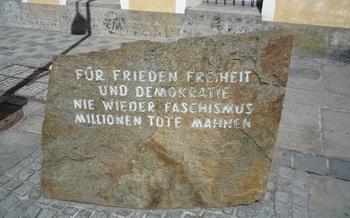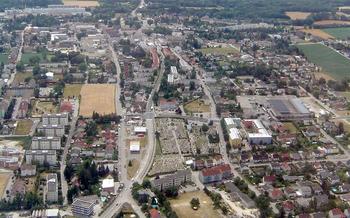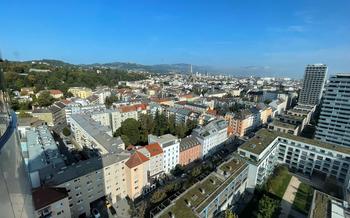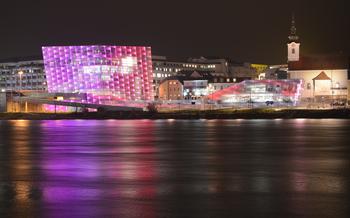
Mauthausen Concentration Camp Memorial
- History of the Mauthausen Concentration Camp
- Location and Accessibility
- Preservation and Memorialization
- Exhibitions and Displays
- Memorial Grounds: A Place of Remembrance and Reflection
- Stories of Prisoners
- Educational Programs
- Guided Tours: Unveiling the Depths of History
- Visitor Etiquette: Honoring the Victims through Respectful Conduct
- Photography and Documentation
- Emotional Impact
- Local Accommodation
- Visitor Reviews and Feedback
- Insider Tip: A Deeper Connection through Art
History of the Mauthausen Concentration Camp
During World War II, the Nazi regime established the Mauthausen Concentration Camp in Upper Austria, a short distance from the town of Enns. Initially created as a subcamp of Gusen, it later became an independent camp in 1940. Mauthausen served as a major hub within the Nazi concentration camp system, with over 200,000 prisoners passing through its gates.
Location and Accessibility
The Mauthausen Concentration Camp Memorial is situated in the town of Mauthausen, approximately 20 kilometers east of Linz, Austria. To reach the memorial site, visitors can take the A1 motorway from Vienna or Salzburg and exit at St. Valentin. From there, follow the signs to Mauthausen. The memorial is conveniently accessible by public transportation, with regular trains and buses connecting Mauthausen to nearby cities such as Linz and Vienna. Once in Mauthausen, visitors can walk or take a short bus ride to the memorial site, which is well-signposted. Guided tours of the memorial are available in several languages and offer a deeper understanding of the camp's history and significance. These tours are led by knowledgeable historians or former prisoners who share their insights and experiences, providing visitors with a more personal and immersive connection to the site.
Preservation and Memorialization
The Mauthausen Concentration Camp Memorial stands as a solemn testament to the atrocities committed during the Nazi regime. Recognizing its immense historical significance, extensive efforts have been undertaken to preserve and restore the camp's original structures. These efforts aim to maintain the authenticity of the site and ensure that future generations can learn from the horrors that occurred within its walls.
Preserving such sites as memorials is crucial for historical remembrance and understanding. They serve as physical reminders of the suffering endured by countless individuals and provide tangible evidence of the dark chapters in human history. By preserving the Mauthausen Concentration Camp, we honor the victims and ensure that their stories are not forgotten.
The memorial site offers a range of educational initiatives and programs designed to deepen visitors' understanding of the Holocaust. These programs include guided tours, workshops, and seminars that explore the camp's history, the experiences of prisoners, and the broader context of the Nazi regime. Through these initiatives, the memorial aims to educate visitors about the dangers of intolerance, hatred, and discrimination, and to promote understanding and reconciliation.
Exhibitions and Displays
The Mauthausen Memorial displays a wide range of exhibits that vividly portray the camp's history and the lives of those who suffered within its walls. Through multimedia presentations, artifacts, and personal accounts, visitors gain a profound understanding of the atrocities committed during the Holocaust.
Interactive displays allow visitors to explore the camp's layout, witness the daily lives of prisoners, and learn about the various forms of torture and abuse they endured. The exhibits include photographs, documents, and personal belongings that belonged to prisoners, providing a tangible connection to their experiences.
A particularly poignant section of the memorial is dedicated to the children who were imprisoned and murdered at Mauthausen. Their stories, told through artifacts and personal accounts, serve as a heartbreaking reminder of the innocent lives lost during the Holocaust.
Memorial Grounds: A Place of Remembrance and Reflection
The memorial grounds at the Mauthausen Concentration Camp Memorial are a serene and contemplative space dedicated to honoring the victims and preserving their memory. The tranquil environment invites visitors to reflect on the atrocities that occurred within these walls and to pay their respects to those who suffered and perished.
As you walk through the grounds, you will encounter various commemorative monuments and sculptures that serve as poignant reminders of the lives lost. The central memorial, known as the "Bell of Peace," stands as a symbol of hope and reconciliation. Its gentle chimes reverberate through the air, echoing the message of peace and remembrance.
Other sculptures and monuments scattered throughout the grounds depict the suffering and resilience of the prisoners. The "Wall of Names" bears the names of thousands of victims, a testament to the individual lives that were tragically cut short. The "Stairs of Death," a steep and narrow staircase leading to the quarry, evoke the arduous labor forced upon the prisoners and the countless lives lost during these tasks.
The memorial grounds provide a serene and contemplative space for visitors to reflect on the horrors of the Holocaust and to honor the memory of those who perished. It is a place where the past is remembered, and lessons are learned to prevent such atrocities from happening again.
Stories of Prisoners
The Mauthausen Concentration Camp Memorial preserves and shares the heart-wrenching stories of the individuals who suffered within its walls. These personal accounts offer a profound glimpse into the lives, experiences, and resilience of those who endured unimaginable horrors. Through written testimonies, recorded interviews, and artifacts left behind, visitors can connect with the humanity behind the statistics and grasp the magnitude of the atrocities committed.
These stories are essential in understanding the human toll of the Holocaust and honoring the memory of each victim. They provide a poignant reminder of the courage, determination, and resilience displayed by individuals in the face of adversity, reminding us of the importance of preserving their legacies and fighting against all forms of intolerance and discrimination.
Educational Programs
The Mauthausen Concentration Camp Memorial offers a range of educational programs designed to teach visitors about the Holocaust and its historical significance. These programs are tailored to various audiences, including students, teachers, and the general public.
Workshops and seminars are conducted by experienced educators and historians who provide in-depth insights into the camp's history, the Nazi regime, and the broader context of the Holocaust. These sessions often involve discussions, group activities, and multimedia presentations to promote critical thinking and understanding.
Guided tours led by knowledgeable historians or survivors offer a unique opportunity to learn firsthand accounts of the atrocities that took place within the camp. These tours provide a deeper understanding of the prisoners' experiences, the camp's operation, and its role in the Nazi regime.
By participating in these educational programs, visitors gain a deeper understanding of the Holocaust, its causes, and its consequences. These programs help to combat Holocaust denial and promote remembrance, fostering a sense of responsibility to prevent future atrocities.
Educational programs offered:
- Workshops for students on topics such as the history of the Holocaust, Nazi propaganda, and human rights.
- Seminars for teachers on how to incorporate Holocaust education into their curricula.
- Guided tours for the general public led by experienced educators or survivors.
- Online resources, including lesson plans, historical documents, and multimedia presentations.
Benefits of educational programs:
- Provide a deeper understanding of the Holocaust and its historical significance.
- Promote critical thinking and encourage discussions about important issues.
- Help to combat Holocaust denial and promote remembrance.
- Foster a sense of responsibility to prevent future atrocities.
Guided Tours: Unveiling the Depths of History
Enhance your visit to the Mauthausen Concentration Camp Memorial by taking advantage of the guided tours led by knowledgeable historians or, in some cases, even survivors of the camp. These experts provide a deeper understanding of the site's history, its significance, and the lives of those who suffered within its walls.
Their insights bring the past to life, weaving personal narratives and historical context into a captivating tapestry of remembrance. With a guide, you'll gain a profound appreciation for the atrocities that occurred here and the resilience of those who endured them.
When selecting a tour, consider your interests and needs. Some tours focus on specific aspects of the camp's history, such as its role in the Nazi regime or the experiences of particular prisoner groups. Others provide a more general overview.
Regardless of your choice, a guided tour will enrich your visit, offering a deeper level of understanding and connection to this poignant memorial.
Visitor Etiquette: Honoring the Victims through Respectful Conduct
Visiting the Mauthausen Concentration Camp Memorial requires visitors to adhere to specific guidelines that honor the victims and survivors of the Holocaust. Maintaining silence and refraining from disruptive actions is crucial. Respectful behavior, such as avoiding loud conversations or laughter, shows consideration for the solemn nature of the site. Visitors should treat the grounds with reverence, acknowledging the immense suffering that occurred within the camp's walls. By adhering to these guidelines, visitors can contribute to a peaceful and contemplative atmosphere, allowing them to fully engage with the memorial's powerful message.
Photography and Documentation
When visiting the Mauthausen Concentration Camp Memorial, it is important to be mindful of the sensitive nature of the site and the privacy of victims and survivors. While photography and documentation are allowed, there are certain guidelines that should be followed.
First and foremost, it is essential to respect the dignity and privacy of those who suffered and perished at the camp. Avoid taking photographs of individuals without their consent, and be cautious about capturing images that could be considered disrespectful or intrusive.
Secondly, it is important to maintain a somber tone and avoid taking photographs that could be seen as trivializing the horrors of the Holocaust. Focus on capturing the historical significance of the site, rather than creating sensational or exploitative images.
Finally, remember that the Mauthausen Concentration Camp Memorial is a place of remembrance and reflection. While it is important to document your visit, it is equally important to be present in the moment and allow yourself to be affected by the powerful emotions that the site evokes.
By following these guidelines, you can ensure that your photography and documentation contribute to the collective memory of the Holocaust and honor the victims who suffered at Mauthausen.
Emotional Impact
Visiting the Mauthausen Concentration Camp Memorial can be an emotionally challenging experience. Confronting the atrocities committed during the Holocaust can evoke a range of emotions, including profound sadness, anger, and grief. It is important to be prepared for these emotions and to allow yourself to process them in a healthy way.
During your visit, it is natural to feel overwhelmed by the sheer scale of suffering and loss that took place at Mauthausen. The exhibits and displays can be particularly difficult to view, as they confront you with the harsh realities of life in the camp. It is important to remember that these exhibits serve as a reminder of the victims and their experiences, and that they are essential for understanding the horrors of the Holocaust.
If you find yourself feeling particularly emotional during your visit, there are several things you can do to cope. Taking breaks throughout the tour can help you process your emotions and avoid becoming overwhelmed. There are also designated quiet areas within the memorial where you can sit and reflect in private. Additionally, there are trained staff and volunteers on site who are available to offer support and guidance if needed.
It is important to remember that everyone experiences the memorial in their own way. There is no right or wrong way to feel, and it is important to allow yourself to process your emotions in a way that feels comfortable for you. After your visit, it may be helpful to talk to a friend, family member, or therapist about your experiences. Writing or journaling about your visit can also be a helpful way to process your emotions and reflect on what you have learned.
Local Accommodation
When planning your visit to the Mauthausen Concentration Camp Memorial, consider staying overnight in the nearby town of Enns. Several hotels and guesthouses offer comfortable accommodations within a short distance of the memorial.
When selecting your accommodation, proximity to the memorial is a key factor. Look for hotels or guesthouses located within walking distance or a short bus or taxi ride away. This will allow you to easily access the memorial and avoid transportation hassles.
Amenities are another important consideration. Choose a hotel or guesthouse that offers the amenities you need for a comfortable stay, such as a private bathroom, Wi-Fi, and breakfast. If you're traveling on a budget, there are several affordable options available, including hostels and guesthouses.
To find the best deals on accommodation, book your stay in advance, especially during peak tourist season. Check online travel agencies and hotel websites for discounts and special offers. Additionally, consider staying in neighboring towns or villages, which may offer more affordable options while still being within a reasonable distance of the memorial.
Visitor Reviews and Feedback
The Mauthausen Concentration Camp Memorial has received overwhelmingly positive reviews from visitors, who commend its well-preserved state, informative exhibits, and respectful atmosphere. Many visitors express a deep sense of emotion and gratitude for the opportunity to learn about and pay tribute to the victims of the Holocaust.
However, some visitors have noted that the tour can be emotionally challenging, highlighting the importance of being prepared for the graphic content and potential triggers. It's advisable to take breaks during the tour if needed and seek support from fellow visitors or staff members if you feel overwhelmed.
Reading visitor reviews can provide valuable insights into the overall experience and help you gauge the suitability of the memorial for your interests and emotional well-being. Don't forget to leave your own feedback after your visit to contribute to the collective understanding of this important historical site.
Insider Tip: A Deeper Connection through Art
Beyond the historical significance and educational exhibits, the Mauthausen Concentration Camp Memorial also houses a poignant collection of artwork created by former prisoners. These artworks, ranging from paintings to sculptures and drawings, offer a unique perspective on the camp's horrors and the resilience of the human spirit.
Take the time to explore the art gallery within the memorial, where you can witness the raw emotions and experiences of those who endured the unimaginable. Through their art, these former prisoners have left behind a powerful legacy that speaks to the strength of the human spirit, even in the darkest of times.
Allow yourself to be moved by these artistic expressions, as they provide a deeper connection to the personal stories of those who suffered and survived.









